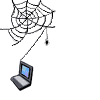WHAT IS AVAILABLE ON THE INTERNET
E-MAIL
E-mail is the first of the Internet tools dedicated to the provision of fast, simple and global communication between people. The initial format of e-mail was one to one exchange of electronic messages and this was improved by e-mails ability to handle various attachments such as documents with complex formatting, numbers and graphic files.
FILE TRANSFER PROTOCOL
This is the rules for transferring files from one computer to another via the Internet and was first introduced to the Internet in 1985.
TELNET
![]()
This was invented in 1980. It allows people to login remotely into any networked computer in the world and use the resources on such a computer such as games, databases library catalogues etc.
USENET NEWSGROUPS
USENET NEWSGROUPS were first pioneered in 1979 and allows individuals join discussion groups about a common subject. The name of a newsgroup describes the type of information it discusses. You subscribe to newsgroups that you want to read on a regular basis.
INTERNET RELAY CHAT (IRC)
This was developed in 1988 and allows messages which are typed into a network computer to be displayed at the exact moment of their formation on screens of other interconnected machines. The IRC technology established chat rooms or channels where strangers can chat anonymously as they use a nickname to preserve their real identity.
WWW

The World Wide Web consist of millions of pages of information stored on thousands of server computers all over the world and was created in 1991. In order to view pages on the web a software program called a browser is required.
Pages on the Web are linked together using hyperlinks. A hyperlink can be text, graphics or pictures. The hypertext principle means that any part of any text or graphic document can act as a portal loading directly to any other nominated segment of any other document anywhere in the world.
All pages on the Web are written in HTML (Hypertext Mark-up Language) or variations of it such as XML, Dynamic HTML and WML, this code based language tells a Web browser how the page should be displayed. To find out specific information on the Web requires the use of a search engine.
Search engines search databases by using keywords. Search engines are indexes of World Wide sites usually built by a program called a spider. These programs search the Web constantly and return with information about a page location title and contents, which is then added to the index. Just type in a keyword and the search engine will display a list of sites containing these words.